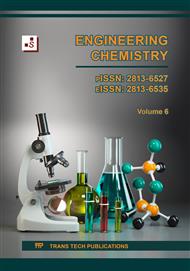[1]
Y. Yanping. The development of polyurethane. Materials Science: Materials Review, 1(2018).
Google Scholar
[2]
J.O. Akindoyo, M.D.H. Beg, S. Ghazali, M.R. Islam, N. Jeyaratnam, and A.R. Yuvaraj. Polyurethane types, synthesis and applications – a review. RSC Adv, 6 (2016)114453–114482.
DOI: 10.1039/c6ra14525f
Google Scholar
[3]
H.J. Choi, H. Choe, W.J. Seo, and J.H. Kim. Physical properties of flexible polyurethane foams manufactured by varying toluene diisocyanate contents. Polymer. 43 (2019)
DOI: 10.7317/pk.2019.43.4.532
Google Scholar
[4]
J. Fu et al. Research progress of UV-curable polyurethane acrylate-based hardening coating. Progress in Organic Coatings. 131 (2019).
DOI: 10.1016/j.porgcoat.2019.01.061
Google Scholar
[5]
R. Tajau et al. Emergence of Polymeric Material Utilising Sustainable Radiation Curable Palm Oil-Based Products for Advanced Technology Applications. Polymers. 13 (2021)1865.
DOI: 10.3390/polym13111865
Google Scholar
[6]
M. A. Sawpan.nPolyurethanes from vegetable oils and applications: a review. Journal of Polymer Research, 25(2018) 184.
Google Scholar
[7]
Y. Xu, L. Yu, W. Li, P. Ciais, Y. Cheng, and P. Gong. Annual oil palm plantation maps in Malaysia and Indonesia from 2001 to 2016. Earth Syst Sci Data. 12 (2020) 847–867.
DOI: 10.5194/essd-12-847-2020
Google Scholar
[8]
R. Tajau, R. Rohani, and M. Z. Salleh. Physicochemical and Thermal Properties of Acrylated Palm Olein as a Promising Biopolymer. J Polym Environ. 28 (2020).
DOI: 10.1007/s10924-020-01797-6
Google Scholar
[9]
R. Tajau, M. I. Ibrahim, N. M. Yunus, M. H. Mahmood, M. Z. Salleh, and N. G. N. Salleh. Development of palm oil-based UV-curable epoxy acrylate and urethane acrylate resins for wood coating application. AIP Conference Proceedings.(2014) 164–169.
DOI: 10.1063/1.4866125
Google Scholar
[10]
S. K. Ghazali, N. Adrus, R. A. Majid, F. Ali, and J. Jamaluddin. UV-LED as a New Emerging Tool for Curable Polyurethane Acrylate Hydrophobic Coating. Polymers (Basel).12 (2021) 487.
DOI: 10.3390/polym13040487
Google Scholar
[11]
Y. Su, S. Zhang, Y. Chen, T. Yuan, and Z. Yang. One-step synthesis of novel renewable multi-functional linseed oil-based acrylate prepolymers and its application in UV-curable coatings. Prog Org Coat. 148 (2020).
DOI: 10.1016/j.porgcoat.2020.105820
Google Scholar
[12]
A. J. Raychura, S. Jauhari, V. S. Prajapati, and B. Z. Dholakiya. Synthesis and performance evaluation of vegetable oil based wood finish polyurethane coating. Bioresour Technol Rep. 3 (2018).
DOI: 10.1016/j.biteb.2018.06.007
Google Scholar
[13]
W. Zhang, Y. Gao, H. Yang, Z. Suo, and T. Lu. Fatigue-resistant adhesion I. Long-chain polymers as elastic dissipaters. Extreme Mech Lett. 39 (2020).
DOI: 10.1016/j.eml.2020.100813
Google Scholar
[14]
M.Z. Salleh, K. Badri, R. Tajau, and N.G. Salleh. The production of green polymer - Hyperbranched curable palm oil oleic acid. Advanced Materials Research (2014).
DOI: 10.4028/www.scientific.net/amr.1024.197
Google Scholar
[15]
X. Li et al. UV LED curable epoxy soybean-oil-based waterborne PUA resin for wood coatings. Prog Org Coat. (151) 2021.
DOI: 10.1016/j.porgcoat.2020.105942
Google Scholar
[16]
Y.M. Ha et al. Ultraviolet-curable optically clear resins using novel fluorinated imide-modified urethane acrylates. Mater Today Commun. 33(2022) 104370.
DOI: 10.1016/j.mtcomm.2022.104370
Google Scholar
[17]
C.S. Wong and K.H. Badri. Chemical Analyses of Palm Kernel Oil-Based Polyurethane Prepolymer. Materials Sciences and Applications. 3 (2012).
DOI: 10.4236/msa.2012.32012
Google Scholar
[18]
T.V. Nguyen et al. The role of organic and inorganic UV-absorbents on photopolymerization and mechanical properties of acrylate-urethane coating. Mater Today Commun. 22 (2020) 100780.
DOI: 10.1016/j.mtcomm.2019.100780
Google Scholar
[19]
W. Xu, W. Wang, L. Hao, W. Zhao, H. Liu, and X. Wang. Effect of generation number on properties of fluoroalkyl-terminated hyperbranched polyurethane latexs and its films. J Appl Polym Sci. 137 (2020).
DOI: 10.1002/app.49215
Google Scholar
[20]
P.M. Paraskar, V. M. Hatkar, and R. D. Kulkarni. Facile synthesis and characterization of renewable dimer acid-based urethane acrylate oligomer and its utilization in UV-curable coatings. Prog Org Coat. 149 (2020).
DOI: 10.1016/j.porgcoat.2020.105946
Google Scholar
[21]
J. Xu et al. Synthesis of UV-curing waterborne polyurethane-acrylate coating and its photopolymerization kinetics using FT-IR and photo-DSC methods. Prog Org Coat. 122 (2018) 10–18.
DOI: 10.1016/j.porgcoat.2018.05.008
Google Scholar
[22]
S. Kotanen, T. Laaksonen, and E. Sarlin. Feasibility of polyamines and cyclic carbonate terminated prepolymers in polyurethane/polyhydroxyurethane synthesis. Mater Today Commun. 23 (2020).
DOI: 10.1016/j.mtcomm.2019.100863
Google Scholar



